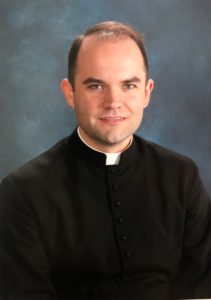
Father Aaron Williams
SPIRIT AND TRUTH
By Father Aaron Williams
The Advent season is one of my favorite seasons of the year — mainly because of the texts used in the liturgy during this time of expectation and hope. One of my favorite lines in the breviary during this season comes on the Second Sunday of Advent. “The Lord will surely come and will not be late; if he seems to delay, wait for him.” Another ancient text for Advent speaks of looking to Christ coming on the last day. “I look from afar: and lo, I see the power of God coming and a cloud covering the whole earth.”
Advent has always been a time of double-expectation. On one hand, we are expectant of the birth of Christ on Christmas day. But, on the other we are hopeful for the final return of our Lord in the end. Of that day, Christ says, “Just as lightning comes from the east and flashes as far as the west, so will be the coming of the Son of Man.” Christian tradition has always associated the East with the coming of Christ. We can even make a simile of it: Christ the Rising Son will come as the rising of the sun.
For this reason, Christian worship from ancient times was even oriented physically towards the east. Many of our Churches are built so that the faithful face East in their pews. Old Catholic cemeteries were often designed so that the grave plots faced East — giving a sign that even the dead remain hopeful for the return of Christ. For the majority of liturgical history, Catholic worship was always totally oriented towards the East with even the priest facing towards the rear wall of the Church where there was an image of Christ displayed — both priest and faithful looking hopefully towards Christ.
In the reformed liturgy, room was given in the new missal to allow priests to begin celebrating the Mass facing the people. This became popular throughout the world, and with the exception of some chapels and churches without free-standing altars, has nearly become the entirely universal practice in the Roman Church today. It is worth mentioning, however, that even in the modern form of the Mass where such a face-to-face orientation is allowed (and common), Eastward celebration by the celebrant was never outlawed. On the contrary, even the modern Roman Missal assumes this orientation and gives directions to the priest as to when he should momentarily turn around at various points in the Mass in order to address the faithful behind him.
In fact, in recent years, some high-ranking officials in the Church, including Robert Cardinal Sarah — the head of the Vatican’s own liturgy office — have encouraged priests to reconsider this ancient posture. Even the former chairman of the U.S. Bishop’s office of Divine Worship, Bishop Arthur Serratelli, wrote a letter to all the bishops of the United States last year where he underscored that this was a legitimate option even in today’s liturgy, though adding that such a decision should take into account the spirit of the parish and the vision of the bishop in his own diocese. In other Christian liturgical rites (such as the Eastern/Greek liturgy), Eastward orientation is still the assumed and required posture.
So, while I would certainly underscore Bishop Serratelli’s comment regarding the pastoral considerations such a decision should require, it is helpful to look upon this ancient custom with a true understanding of its meaning. Regrettably, most people associate this posture with a sort of “clerical” understanding of the Church, where priests are disinterested with he faithful and thus approach the Mass with their “backs facing them.” But, this is not a helpful perspective on our own rich liturgical history, which is far more rooted in theological ideas than such base considerations.
For our own purposes, perhaps during this Advent season we can encourage a spirit of “Eastward worship” in our own homes by making sure there is a dedicated focus for prayer — a crucifix or a holy image. Families can gather and pray together before these images, and remain hopeful for the coming of Christ the Lord in all his glory.
(Father Aaron Williams is the parochial vicar at Greenville St. Joseph Parish and serves as the liaison to seminarians for the Office of Vocations.)
